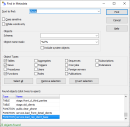Specific Data Functions
The Database Tour has a large set of functions for different types of database fields like text, numeric, graphic etc. Some of them of course can be executed using Database Tour SQL tools, but having specific GUI often simplifies the task.
Searching and Replacing Text in DB
You can search and replace text in a data set (Table or SQL query result). The functionality also covers Memo, CLOB and text compatible BLOB columns.
It is also possible to search and replace code in SQL windows and schema files. And some interface parts of the application are searchable too.
Blob Viewer and Editor
BLOB and CLOB fields allow to store different kinds of binary and text data like graphics, large text, database reports etc. Blob Editor is a tool to work with such data.
Searching for Database Objects
There is a possibility to search text not only in the table data, but in the database metadata too. For example, you may need to find a table by its field name or a stored procedure by its code fragment. In high-level databases, you have dozens of database object types like views, triggers, sequences, database links, jobs, etc., and Database Tour allows to find them by their text or descriptions.
Working with Database Objects Descriptions
Some server databases like Oracle, SQL Server, PostgreSQL, MySQL allow you describe the tables and their columns right in the database. Those descriptions can be used for documenting your systems and working environment. Database Tour facilitates working with table and column description by providing a unified and easy-to-use interface.
The descriptions from database can be exported to a number of common formats like Excel or HTML, and thus easily embedded in your company documentation, for example.
Batch Operations with Text Fields
You can use several useful functions for selected fields of a dataset: trimming, changing case of symbols etc.
Calculating Data in Numeric Fields
You can perform several arithmetic operations like sum, average, min, max with a certain numeric field of the open dataset without needing to write a SQL query for that.





